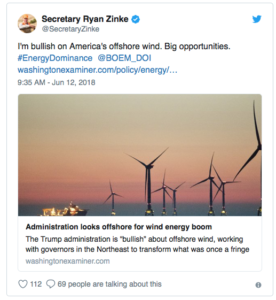
Aug 3, 2018
Once more I’d like to express my gratitude at having been given the opportunity to attend the WINDPOWER conference as this year’s scholarship recipient. It was truly motivating to be surrounded by so many established professionals who are not only willing, but eager to share their passion for this field. I had the privilege of attending a handful of sessions, poster presentations, and panel discussions; and took the opportunity to really involve myself in many of the activities that took place throughout the conference. Though there was much ground to cover—especially as a newcomer, I found many of the sessions stimulating and helpful in allowing me to glimpse into the many different sectors involved in this industry. One of the highlights of my time at WINDPOWER was not only getting to network and meet established individuals in the field, but also connecting with other newcomers who like myself are trying to pave their way in this industry. In addition, it was great to see an event like this also actively work to foster a passion for renewable energy in younger children by way of the KidWind Challenge – speaking to them and seeing their ingenuity and inventiveness further demonstrated to me that there’s so much to do for these younger generations. Overall, my biggest takeaway lied in that though there’s much one can be part of now, this industry is growing and actively looking for ways to improve and knowing this furthers my drive to want to help push this industry forward. Thank you again for this amazing opportunity!
– Lucy Tafur, Engineer Project Associate, AWS Truepower
Aug 3, 2018
WRISE San Diego would like to thank all participants from last week’s summer social event. This event was a part of an ongoing series on Career and Life Development offered by WRISE San Diego. At this event, we were able to view two TED Talks series:
“Own Your Behaviors, Master Your Communication, Determine Your Success,” Louise Evans, TEDxGenova & “The Power of Vulnerability,” Brené Brown
Both videos focused on how we can direct the course of our personal and professional lives with courage, vulnerability and whole-heartedness in order to become our very best selves. These videos also stressed how we need to pause before we respond to other people’s actions, and how to live life more authentically. Our attendees were provided the opportunity to share their personal stories and experiences on ‘Being Enough,’ when to say ‘No’ and the importance of establishing personal boundaries. Overall, it was a delightful event in an intimate setting with some wonderful insights shared by our attendees.
Also, we missed those of you who were unable to attend our event. We did hear about the brushfire closer to our venue on I-15 close to Rancho Bernardo area in North County, making it challenging to attend. Hope you are all safe, and we hope to see you at future events
WRISE San Diego wishes you all a wonderful weekend and hope you are all enjoying your Summer!
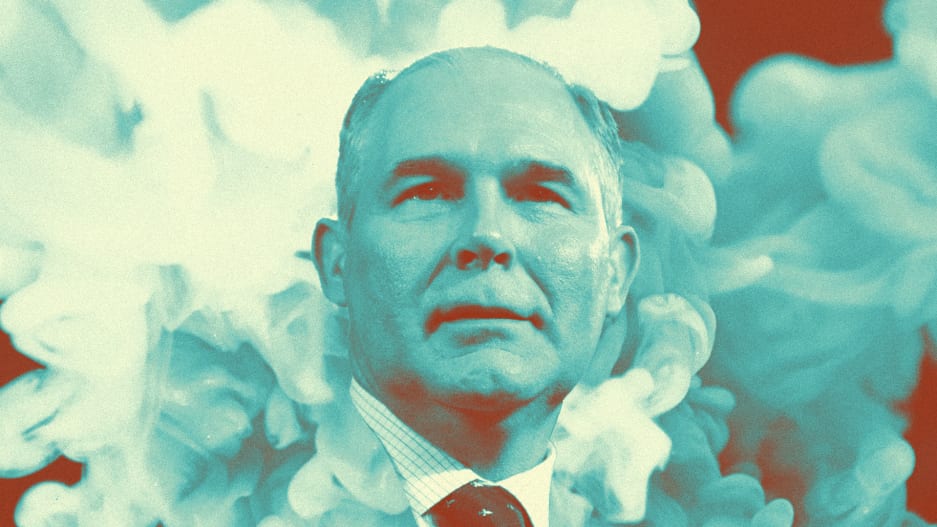
Jun 26, 2018
Source: Fast Company, June 21, 2018
Author: Suzanne Shelton
Source Link: https://www.fastcompany.com/40588208/the-epas-backwards-agenda-is-at-odds-with-what-consumers-want
[Source Photos: Flickr user Gage Skidmore (Pruitt), Rawpixel/Unsplash (smoke)]
The U.S. government is getting out of the green business, right as Americans are jumping in.
Under Scott Pruitt’s leadership, the Environmental Protection Agency has focused its efforts on deregulation. From lead paint to fuel efficiency to wastewater, no environmental regulation is safe from targeting.
Publicly, Pruitt has distanced the EPA from climate change science. Pruitt said on national television that he does not agree that man-made activity is a driver of global warming. Exactly one year ago this month, Pruitt was reportedly the loudest cheerleader for Trump’s decision to pull the U.S. out of the Paris Climate Accord.
Behind the scenes, Pruitt appointed himself the final arbiter of what waters fall under federal regulation of the Clean Water Act. President Trump has directed him to loosen limits on power plants’ greenhouse gas emissions and to toss out the requirement that EPA officials consider climate change impact when making decisions. Pruitt seeks to roll-back Obama-era fuel-economy standards and blocked an Obama-era ban on a pesticide found to cause fetal brain defects and targeted limits on sewage plants’ toxic emissions.Yet as the government pendulum swings away from the environmental regulating business, public opinion is charging full steam ahead in the opposite direction. New Pew Research polling finds that the vast majority of Americans think the federal government is doing too little to combat climate change and protect the environment. When asked about government protection of specific resources:
- 69% of U.S. adults said the government is doing too little to protect water quality in our lakes, rivers, and streams.
- 64% said too little is done to protect our air quality.
- More than two-thirds of Americans think the government is not doing enough to combat the effects of global climate change.
- More than 80% supported the increased use of wind and solar power.
But this unity collapses when people are asked more broad questions. When asked about government policies aimed at reducing climate change to benefit the environment in general:
- 72% of Republicans say these government policies either make no difference or do more harm than good.
- 66% of Democrats say these government policies do help the environment.
What gives?
The difference is specificity. Our current political climate is supercharged with hyper-partisanship. Everyone carries closely held opinions on the appropriate place of government and the role it should play in the marketplace and in our individual lives. But those reflexive opinions aren’t as triggered by specific questions on resources and renewable energy sources. Everyone wants to drink clean water and breathe clean air, regardless of whether you watch MSNBC or Fox News. The key to agreement is to take the debate away from the ballot box and triggering language.
That’s where corporations come in. Businesses are uniquely suited to fill this leadership gap and capitalize on consumer desire for specific action.
Our research suggests that consumers increasingly approve of and seek out brands setting sustainability goals in their lane of expertise, particularly when brands are vocal about their commitment. Anheuser-Busch, for example, is now selling each bottle of Budweiser with a new logo spotlighting that it was brewed with 100% renewable electricity. The focus is on the sustainable difference beer brewing can make, not a he said/she said on global warming–and that makes all the difference. Similarly, Volvo is banking on its public commitment to electric vehiclesdriving its brand and sales goals into the future. The focus is on what consumers want; not fuel-efficiency regulations. The North Face is launching a refurbished clothing initiative to give consumers access to more affordable apparel from the brand and reduce discarded textiles in landfills. The focus is on reuse and affordability.
For each of these brands, the focus is on consumers; not on environmental regulations.
These smart investments in sustainability attract both red state and blue state consumers. Whether you distrust big government or distrust the party in control of the government, the public wants action to protect our environment, just not always from Uncle Sam. Businesses are the natural heir to fill this leadership void in this hyper-partisan time–and reap the rewards in the process.
Suzanne Shelton is president and CEO of Shelton Group, the nation’s leading marketing communications agency focused exclusively on energy and the environment.

Jun 26, 2018
Source: North American Windpower, June 21, 2018
Author: Betsey Lillian
Source Link: https://nawindpower.com/energy-jobs-for-our-heroes-act-would-help-veterans-secure-clean-energy-careers
A newly introduced bipartisan bill aims to help U.S. veterans gain training and credentials to secure jobs in the fast-growing sectors of the low- and zero-carbon-emissions energy industry.
U.S. Sens. Tammy Duckworth, D-Ill., Lindsey Graham, R-S.C., and Michael Bennet, D-Colo., have introduced the Energy Jobs for our Heroes Act of 2018, which is designed to help ease the transition back to civilian life for servicemembers and strengthen the economy by connecting employers in solar, wind, nuclear and cyber energy industries with veterans.
“I am proud to partner with Sens. Graham and Bennet on this bipartisan legislation to help servicemembers transition back to civilian life and find good-paying jobs in clean, renewable energy,” says Duckworth. “Our bill will provide servicemembers and veterans with the training they need to work in some of our nation’s fastest-growing industries while also helping clean energy companies – which already employ veterans at high rates across the country – find highly skilled and dedicated workers as they experience exponential growth and provide more of our nation’s energy supply.”
“I’m very excited to be a part of this effort to do two great things for our country: help veterans find jobs and boost the clean energy economy,” says Graham. “If there was ever a win-win, it is this bill. I’m really pleased to be working with Sens. Duckworth and Bennet on this important legislation.”
“For years, we’ve worked to ensure veterans are equipped to enter the clean energy industry, especially in Colorado,” adds Bennet. “This bipartisan bill will create a pathway so our veterans, who have put their lives on the line for our country, have the necessary skills and training to compete in our 21st-century economy. We’re encouraged by the administration’s commitment to prioritize this legislation.”
During a Senate committee hearing in March, Duckworth received a commitment from Rick Perry, U.S. Department of Energy (DOE) secretary, to work on advancing the legislation.
Specifically, the bill would direct the DOE to partner with the U.S. Department of Defense to develop an “Energy Ready Vets Program.” The program would be led by an administrator with military experience and would offer veterans and members of the Armed Forces six-month internships to gain hands-on training. It would also establish a labeling program that recognizes companies that are hiring graduates of these programs in order to encourage them to hire veterans.
Citing the DOE, the senators say veterans currently make up 11.5% and 11.1% of the wind and solar workforces, respectively.
Supporting the newly proposed bill is the American Wind Energy Association (AWEA). In a statement, Bree Raum, AWEA’s vice president of federal affairs, says, “AWEA endorses the Energy Jobs for our Heroes Act of 2018 and applauds Sens. Tammy Duckworth, Lindsey Graham and Michael Bennet for their leadership in helping veterans enter the energy workforce after serving their country. The wind industry is proud that we hire veterans at a rate that is 72 percent higher than the national average. This legislation will help us welcome even more of our nation’s heroes into the American wind energy workforce.”
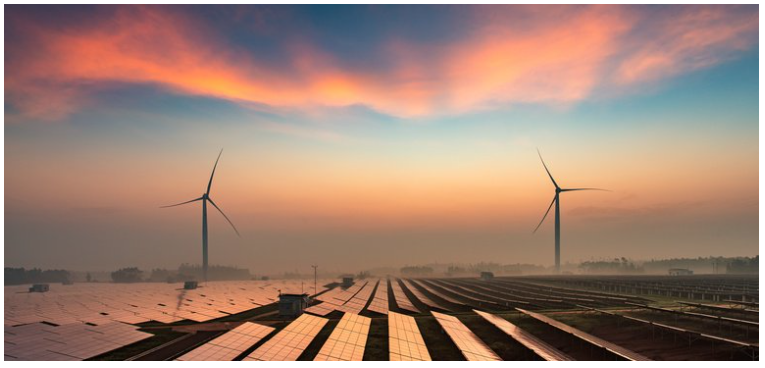
Jun 21, 2018
Source: Utility Dive
Author: Robert Walton
Source Link: https://www.utilitydive.com/news/world-on-track-for-50-renewables-by-2050-says-bloomberg-energy-outlook/526052/
__________________
Dive Brief:
- A new analysis from Bloomberg New Energy Finance predicts a global electricity supply mostly fueled by carbon-free sources by 2050, with a “chilling” outlook for fossil fuel generators and little hope for a nuclear resurgence with today’s technology.
- The New Energy Outlook report concludes a “dramatic shift” to “50 by 50” is being driven by cheap renewables generation and falling battery costs. Solar and wind costs are expected to drop 71% and 58%, respectively, by 2050.
- Worldwide, the report predicts $548 billion will be invested in battery capacity by 2050, with two-thirds of that at the grid level and the remaining third installed behind-the-meter.
Dive Insight:
In total, Bloomberg’s new analysis sees $11.5 trillion being invested globally in new power generation capacity from 2018 to 2050, with the majority going towards renewables. About $8.4 trillion will be spent on wind and solar, and another $1.5 trillion on other zero-carbon technologies such as hydro and nuclear.
“The arrival of cheap battery storage will mean that it becomes increasingly possible to finesse the delivery of electricity from wind and solar, so that these technologies can help meet demand even when the wind isn’t blowing and the sun isn’t shining,” BNEF’s Seb Henbest said in the report. “The result will be renewables eating up more and more of the existing market for coal, gas and nuclear.”
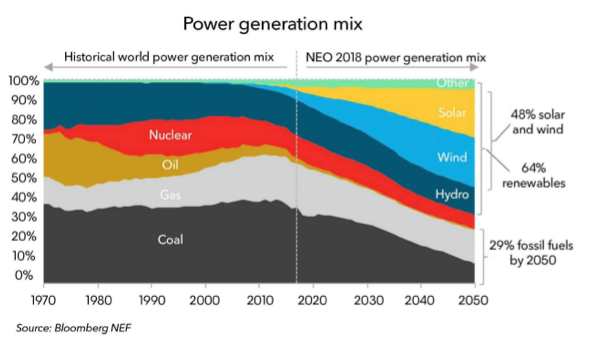 According to the report, since 2010, the price of lithium-ion batteries has declined 79%. Now, stand-alone batteries are increasingly cost-competitive with open-cycle gas plants and other options such as pumped hydro. “The conclusions are chilling for the fossil fuel sector,” Elena Giannakopoulou, head of energy economics at BNEF, said in the report.
According to the report, since 2010, the price of lithium-ion batteries has declined 79%. Now, stand-alone batteries are increasingly cost-competitive with open-cycle gas plants and other options such as pumped hydro. “The conclusions are chilling for the fossil fuel sector,” Elena Giannakopoulou, head of energy economics at BNEF, said in the report.
In the United States, Bloomberg expects batteries to grow in significance from around 2030, to support renewables penetration. Utilities will continue to replace older coal and nuclear with cheaper gas and renewables, though Bloomberg adds the qualifier, “assuming there is no lasting federal policy intervention” to keep them operating.
The Trump Administration has been working to develop policies to support nuclear and coal plants, going so far as to propose unprecedented market intrusions. For coal plants, however, many in the power industry think there is little that can be done to stop the fuel’s downward trend in the U.S.
“Coal and nuclear are pushed out by age and economics, such that by 2050 both nuclear and coal have almost disappeared from the electricity mix,” the report predicts for the United States. “We do not anticipate a U.S. nuclear renaissance with current technology.”
The struggle of emissions-free nuclear plants has created a dilemma for U.S. policy makers who want to keep the plants online but are seeing them struggle economically and retire. Many in the nuclear industry are looking to smaller, modular reactors as a way to revive the struggling technology.
The smaller nuclear plants could start at prices as low as $1 billion to $1.5 billion to construct, according to some experts. While many believe SMRs could propel new growth in the nuclear industry, there may be less hope for fossil fuels according to Bloomberg.
“The economic case for building new coal and gas capacity is crumbling, as batteries start to encroach on the flexibility and peaking revenues enjoyed by fossil fuel plants,” the report finds.
SaveSave
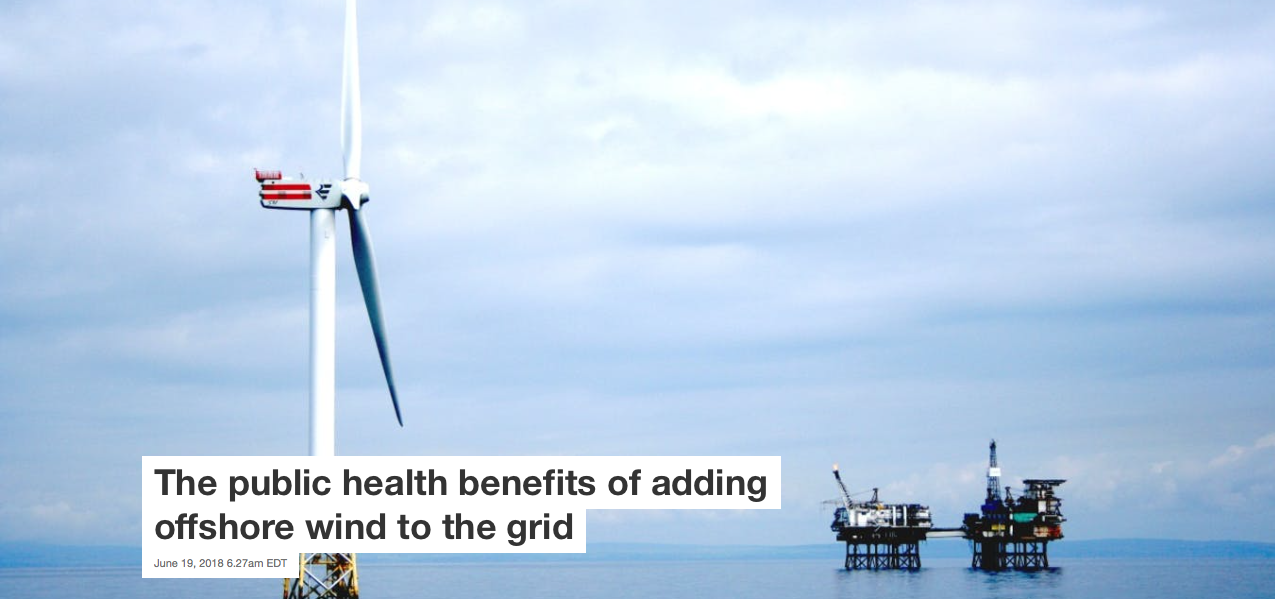
Jun 20, 2018
Source: The Conversation
Author: Jonathan Buonocore, Research Associate, Center for Climate, Health and the Global Environment, Harvard T.H. Chan School of Public Health, Harvard University
Link to source site: https://theconversation.com/the-public-health-benefits-of-adding-offshore-wind-to-the-grid-98228
________________
New plans to build two commercial offshore wind farms near the Massachusetts and Rhode Island coasts have sparked a lot of discussion about the vast potential of this previously untapped source of electricity.
But as an environmental health and climate researcher, I’m intrigued by how this gust of offshore wind power may improve public health. Replacing fossil fuels with wind and solar energy, research shows, can reduce risks of asthma, hospitalizations and heart attacks. In turn, that can save lives.
So my colleagues and I calculated the health impact of generating electricity through offshore wind turbines – which until now the U.S. has barely begun to do.
Greening the grid
New England gets almost none of its electricity from burning coal and more than three-quarters of it from burning natural gas and operating nuclear reactors. The rest is from hydropower and from renewable energy, including wind and solar power and the burning of wood and refuse.

The health benefits of moving to wind power would be significant, particularly for regions that rely more heavily on coal and oil to generate electricity.
Replacing coal and oil with offshore wind will reduce emissions of air pollutants like fine particulate matter, nitrogen oxide and sulfur dioxide. These pollutants can form smog, soot and ozone. When people downwind are exposed to them, they can develop incapacitating and deadly diseases.
Saving 13 lives a year
When my colleagues and I studied what would happen if offshore wind farms were installed off the Mid-Atlantic coast, we determined that they would bring about health and climate benefits.
We projected that a 1,100-megawatt wind farm off the coast of New Jersey, a bit smaller than the two approved offshore wind farms, would save around 13 lives per year.
When connected to the grid, this new source of power would make carbon emissions decline by around 2.2 million tons every year, the equivalent to taking over 400,000 cars off the road.
Offshore wind faces a number of technical and economic hurdles, including installation of transmission lines. But at least theoretically, this form of renewable energy could generate enough electricity to supply
all the electricity the U.S. consumes and then some, according to the Energy Department. Members of the Trump administration, including Interior Secretary
Ryan Zinke, appear to support offshore wind.
While it may not be possible, practical or necessary to build offshore wind everywhere, even replacing a small portion of the nation’s fossil-fueled electricity will be good for everyone’s health.
SaveSave
SaveSave
SaveSave
SaveSave
SaveSave
SaveSave
SaveSave
SaveSave








